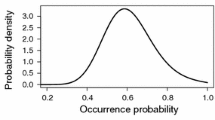Abstract
Predictive models of wildlife-habitat relationships often have been developed without being tested The apparent classification accuracy of such models can be optimistically biased and misleading. Data resampling methods exist that yield a more realistic estimate of model classification accuracy These methods are simple and require no new sample data. We illustrate these methods (cross-validation, jackknife resampling, and bootstrap resampling) with computer simulation to demonstrate the increase in precision of the estimate. The bootstrap method is then applied to field data as a technique for model comparison We recommend that biologists use some resampling procedure to evaluate wildlife habitat models prior to field evaluation.
Similar content being viewed by others
Literature cited
Breiman, L., J. H. Friedman, R. A. Olshen, and C. J. Stone. 1984. Classification and regression trees. Wadsworth, Inc. Belmont, California. 358 pp.
Berry, K. H. 1986. Introduction: development, testing, and application of wildlife-habitat models. Pages 3–4in J. Verner, M. L. Morrison, and C. J. Ralph (eds.), Wildlife 2000: Modeling habitat relationships of terrestrial vertebrates. University of Wisconsin Press, Madison, Wisconsin.
Capen, D. E. (ed.). 1981. The use of multivariate statistics in studies of wildlife habitat. US Forest Service General Technical Report RM-87. Rocky Mountain Experiment Station, Fort Collins, Colorado. 249 pp.
Capen, D. E., J. W. Fenwick, D. B. Inkley, and A. C. Boynton. 1986. Pages 171–175in J. Verner, M. L. Morrison, C. J. Ralph (eds.), Wildlife 2000: Modeling habitat relationships of terrestrial vertebrates. University of Wisconsin Press, Madison, Wisconsin.
Efron, B. 1983. Estimating the error rate of a prediction rule: Improvement on cross-validation.Journal of the American Statistical Association 78:316–331.
Efron, B. 1986. How biased is the apparent error rate of a prediction rule?Journal of the American Statistical Association 81:461–470.
Fish and Wildlife Service 1981. Standards for the development of suitability index models. Ecological Services Manual 103. US Fish and Wildlife Service, Division of Ecological Services, Washington, DC. 68 pp.
Jain, A. K., R. C. Dubes, and C. C. Chen. 1987. Bootstrap techniques for error estimation.IEEE Transactions of Pattern Analysis 9:628–633.
Krebs, C. J. 1989. Ecological methodology. Harper & Row, New York. 654 pp.
Lachenbruch, P. A., and M. R. Mickey. 1968. Estimation of error rates in discriminant analysis.Technometrics 10:1–11.
Litvaitis, J. A., J. A. Sherburne, and J. A. Bissonette. 1985. Influence of understory characteristics on snowshoe hare habitat use and density.Journal of Wildlife Management 49:866–873.
Magnusson, W. E. 1983. Use of discriminant function to characterize ruffed grouse drumming sites in Georgia: A critique.Journal of Wildlife Management 47:1151–1152.
Morrison, M. L. 1984. Influence of sample size on discriminant function analysis of habitat use by birds.Journal of Field Ornithology 55:330–335.
Picard, R. P., and R. D. Cook. 1984. Cross-validation of regression models.Journal of the American Statistical Association 79:575–583.
Rexstad, E. A., D. D. Miller, C. H. Flather, E. M. Anderson, J. W. Hupp, and D. R. Anderson. 1988. Questionable multivariate statistical inference in wildlife habitat and community studies.Journal of Wildlife Management 52:794–798.
Tukey, J. 1958. Bias and confidence in not quite large samples.Annals of Mathematical Science 29:614.
Verbyla, D. L. 1986. Potential prediction bias in regression and discriminant analysis.Canadian Journal of Forest Research 16:1255–1257.
Verner, J., M. L. Morrison, and C. J. Ralph (eds.). 1986. Wildlife 2000: Modeling habitat relationships of terrestrial vertebrates. University of Wisconsin Press, Madison, Wisconsin. 470 pp.
Williams, B. K., and K. Titus. 1988. Assessment of sampling stability in ecological applications of discriminant analysis.Ecology 69:1275–1285.
Author information
Authors and Affiliations
Rights and permissions
About this article
Cite this article
Verbyla, D.L., Litvaitis, J.A. Resampling methods for evaluating classification accuracy of wildlife habitat models. Environmental Management 13, 783–787 (1989). https://doi.org/10.1007/BF01868317
Issue Date:
DOI: https://doi.org/10.1007/BF01868317




